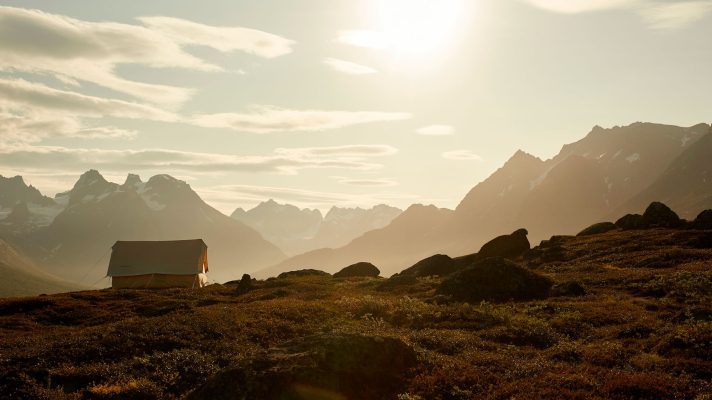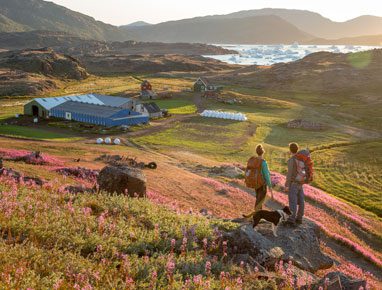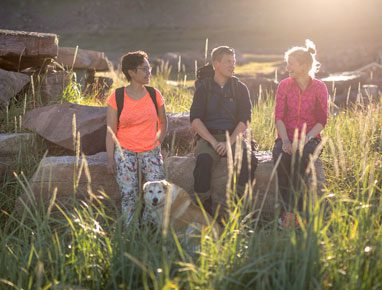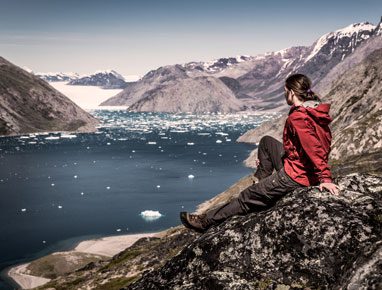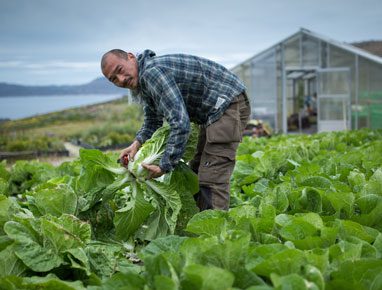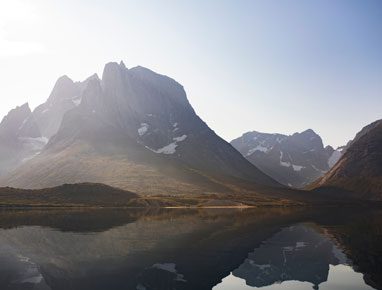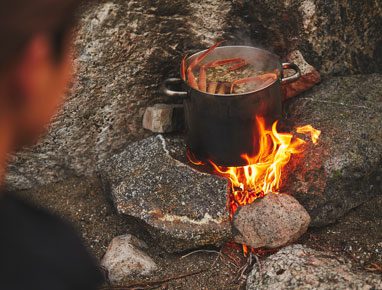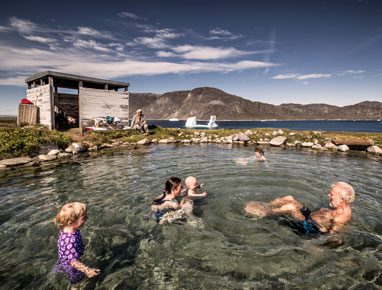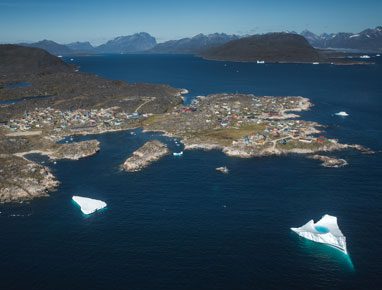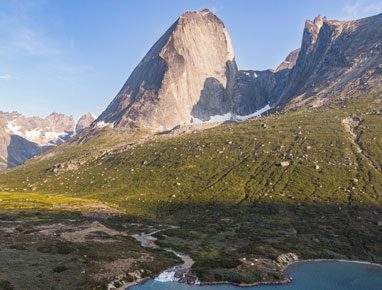Today, we start with breakfast at Hotel Qaqortoq, then head down to the harbor, where we set sail for Nanortalik. It’s a boat trip of about four hours, so we settle in and enjoy the view from the boat. Maybe we’ll be lucky enough to encounter a seal or whale on our way.
Tour of Nanortalik’s colonial neighborhood
Nanortalik is the southernmost town in Greenland and the smallest of the three South Greenlandic towns. The town is home to around 1,100 people and is beautifully situated with high mountain peaks in the background.
Nanortalik has several beautiful colonial buildings, which we go ashore to see during our relatively short visit to Nanortalik. It’s not because it’s a boring town that we don’t stay longer, but in the fjord behind the town lies the attraction that is one of the main goals of our trip.
A notable colonial building in Nanortalik is the Church of Our Savior, which was built in 1905 and is still in use today. It is a traditional, white-painted wooden church with a distinctive bell tower. The old colonial administrator’s house, once used as housing for colonial employees stationed in Nanortalik, is now the town’s museum. A two-story wooden structure, the museum provides an insight into the history of the Danish colonization of Greenland and showcases exhibits from the local Inuit culture and colonial era. We will see many of the town’s most beautiful buildings in this relatively small but centrally located area.
After this tour, we head back to the harbor, and now it’s time to take a new boat into the Tasermiut Fjord, where Kuussuaq Camp is located. We have teamed up with the Greenlandic company Tasermiut Camp, which specializes in camp tours in this beautiful area. But first, we will go on a scenic boat trip between the majestic mountains of Tasermiut.
The Tasermiut Fjord
The Tasermiut Fjord is known for its breathtaking scenery. Above the waters of the fjord rise steep mountains and rugged coastlines. The Tasermiut Fjord is often called “the Arctic Patagonia” because towering granite peaks, glaciers, and untouched wilderness also characterize this Arctic area. The fjord offers excellent hiking and wildlife-watching opportunities, including the chance to see seals, whales, and seabirds.
Many world-famous mountaineers have come to the Tasermiut Fjord to climb majestic peaks here. Uiluit Qaqqaa (Ketil’s Mountain), Nalumasortoq, and Ulamertorsuaq are the most famous mountains. These granite mountains have extreme challenges for climbers, including more than 1,000-meter-high vertical mountainsides! And we mean vertical! But don’t worry – you’re not here to climb but to hike in the lush nature that is also found in this area.
The adventurous boat trip from Nanortalik to Kuussuaq Camp starts from Nanortalik harbor, from where we sail into the Tasermiut Fjord. Along the way, we say hello to the Tasiusaq village before sailing between the majestic mountains which Tasermiut Fjord is so well-known for. But hey, you might say! We’ve been to Tasiusaq once already! Yes and no, you’ve been to the other famous place in South Greenland called Tasiusaq.
In Greenland, many places are named after their geographical or geological features, and Tasiusaq means “the place that resembles a lake.” Therefore, there are many places called Tasiusaq.
We sail further into the fjord, stopping to get close to the huge glacier. There is something wildly fascinating about the glaciers you find along Greenland’s coasts, and this is one of the very beautiful of them.
After this experience, we sail back and arrive at the campsite where we will be dropped off.
Kuussuaq Camp
Kuussuaq Camp emphasizes the area’s distinctive character with forest, creeks, and the large lake Tasermiut. The camp is located by the creek near the lake, which is why the camp is called “Kuussuaq” – the big creek.
Kuussuaq Camp is not just another stop on our trip; it’s an atmosphere and an authentic vibe. Besides being embedded in breathtaking nature, you are now in a place where nature is your playground. The area around the camp offers, among many other things, a unique opportunity to experience nature’s pantry.
When we arrive at the camp, we’ll have a light snack and find the tent where we’ll stay for the next two days. Afterward, there’s time to socialize, where you can, for example, help stock up on provisions in the beautiful nature surrounding us. We’re really talking “from nature to table” here!
If herbs, mushrooms, or berries are in season, these can be harvested directly from the mountains. You are in the middle of an area where you can explore nature’s pantry and perhaps discover delicacies perfect for our shared meals. And who knows, maybe you’ll also get the chance to fish and add freshly caught fish to our culinary adventures. You might also consider a nice cool swim in the beautiful lake!
Our dinner is made on-site and allows you to taste the Greenlandic cuisine, which is incredibly versatile and delicious.
Later in the evening, there is entertainment with music, and the local guides tell Greenlandic myths and other stories around the campfire.
Please note! Toilet facilities and showers: There is a toilet tent near the camp where you sit on a toilet bucket. After use, you tie a knot on the plastic bag in the bucket and dispose of the bag. This way, the toilet is clean for the next user. The used toilet bags are collected in another container. The camp has no showers, but there is a large lake where you can take a dip if you are up for it. It’s a very authentic Greenlandic experience, but nothing to be nervous about.
